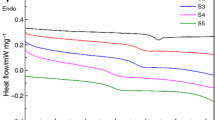Abstract
Thermal and thermo-oxidative decomposition and decomposition kinetics of flame retardant high impact polystyrene (HIPS) with triphenyl phosphate (TPP) and novolac type epoxy resin (NE) were characterized using thermo-gravimetric experiment. And the flammability was determined by limited oxygen indices (LOI). The LOI results show that TPP and NE had a good synthetic effect on the flame retardancy of HIPS. Compared with pure HIPS, the LOI values of HIPS/NE and HIPS/TPP only increased by about 5%, and the LOI value of HIPS/TPP/NE reached 42.3%, nearly 23% above that of HIPS. All materials showed one main decomposition step, as radical HIPS scission predominated during anaerobic decomposition. TPP increased the activity energy effectively while NE affected the thermal-oxidative degradation more with the help of the char formation. With both TPP and NE, the materials could have a comparable good result of both thermal and thermal-oxidative degradation, which could contribute to their effect on the flame retardancy.
Similar content being viewed by others
References
Carty P, White S. Flammability of Polymer Blends[J]. Polymer Degradation and Stability, 1996, 54: 379–392
Smith R, Georlette P, Finberg I, et al. Development of Environmentally Friendly Multifunctional Flame Retardants for Commodity and Engineering Plastics[J]. Polymer Degradation and Stability, 1996, 54: 167–180
Anderson C E, Ketchum D E, Mountain WP. 1, 2-methyl-1,2-oxaphospholan-5-one 2-oxide Fire Retardance in HIPS: The Effect of Melamine and Novolac [J]. Fire Science, 1998, 6:390–398
Grand AF, Wilkie CA. Fire Retardancy of Polymeric Materials[M]. New York: Marcel Dekker; 2000:140–147
Lee Kyongho, Kim Jinhwan, Bae Jinyoung, et al. Studies on the Thermal Stabilization Enhancement of ABS: Synergistic Effect by Triphenyl Phosphate and Epoxy Resin Mixtures [J]. Polymer, 2002, 43: 2 249–2 253
Costa L, Rossi di Montelera L, Camino G, et al. Flame Retardant Properties of Phenol-formaldehyde-type Resins and Triphenyl Phosphate in Styrene-acrylonitrile Copolymers[J]. Journal of Applied Polymer Science, 1998, 68: 1 067–1 076
Costa L, Rossi di Montelera L, Camino G, et al. Structurecharring Relationship in Phenol-formaldehyde Type Resin [J]. Journal of Applied Polymer Science, 1997, 56: 23–35
Morterra C, Low M J D. IR Studies of Carbon VII. The Pyrolysis of a Phenol-formaldehyde Resin [J]. Carbon, 1985, 23:525–533
William M Jackson, Robert T. Conely, High Temperature Oxidative Degradation of Phenol-formaldehyde Polycondensates [J]. Journal of Applied Polymer Science, 1964, 8: 2 163–2 193
Fyfe C A, Mckinnon M S, Rudin A, et al. Investigation of the Mechanism of the Thermal Decomposition of Cured Phenolic Resins by High-resolution 13C CP/MAS Solid-state NMR Spectroscopy [J]. Macromolecules, 1983, 16: 1 216–1 221
Chetan M S, Ghadago R S, Rajan C R,et al. Thermolysis of Orthonovolaks. II. Phenol-formaldehyde and-naphthol-Formaldehyde Resins [J]. Journal of Applied Polymer Science, 1993, 50: 685–696
Boscoletto A B, Checchin M, Tavan M, et al. Combustion and Fire Retardance of Poly (2, 6-dimethyl-1, 4-phenylene ether)-high-impact Polystyrene Blends. I. Morphological aspects[J]. Journal of Applied Polymer Science, 1994, 53: 121–129
Li Huiyong, Cai Changgeng and Jia Demin. Synergism of Epoxy Resin and TPP on Flame Retardancy of HIPS [J]. China Plastics Industry, 2005, 33(10): 53–55
Brauman S K, Chen I J and Matzinger D P. Polystyrene Degradation During Combustion [J]. Journal of Polymer Science: Polymer Chemistry Edition, 1983, 21:1 831–1 845
Martel B. Charring Processes in Thermoplastic Polymers: Effect of Condensed Phase Oxidation on the Formation of Chars in Pure Polymers [J]. Journal of Applied Polymer Science, 1988, 35:1 212–1 226
Author information
Authors and Affiliations
Corresponding author
Additional information
Funded by Guang dong Province Natural Sciences Fundation(No.39672)
Rights and permissions
About this article
Cite this article
Li, H., Cai, C., Chen, Y. et al. Thermal and thermo-oxidative degradation of flame retardant high impact polystyrene with triphenyl phosphate and novolac epoxy resin. J. Wuhan Univ. Technol. 22, 486–489 (2007). https://doi.org/10.1007/s11595-006-3486-3
Received:
Accepted:
Issue Date:
DOI: https://doi.org/10.1007/s11595-006-3486-3




